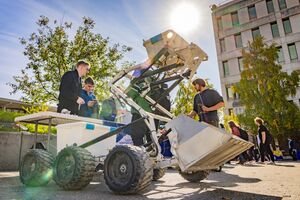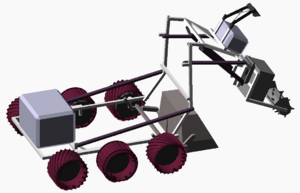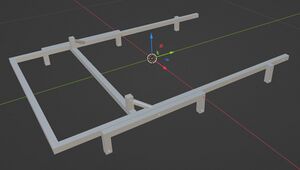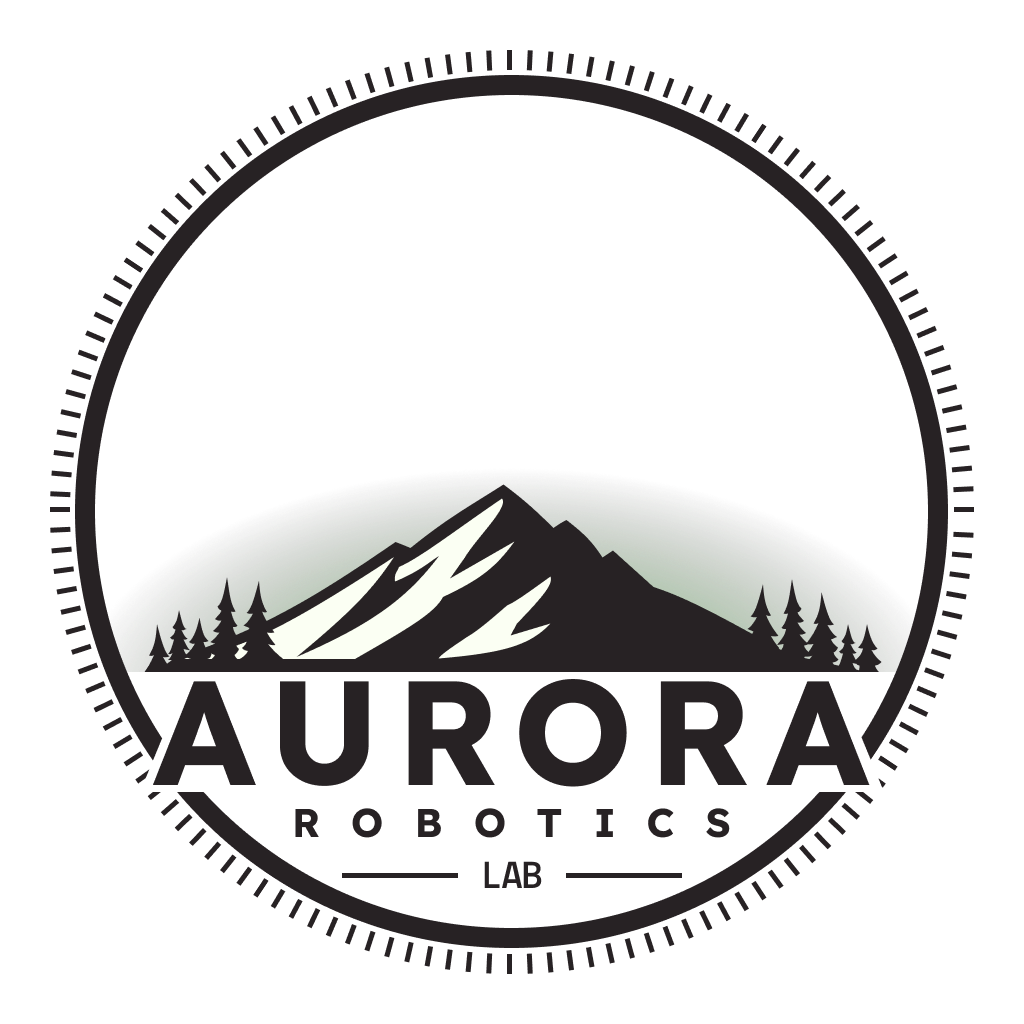Excahauler: Difference between revisions
Acmattson3 (talk | contribs) Added link to Break The Ice |
Acmattson3 (talk | contribs) No edit summary |
||
| (5 intermediate revisions by the same user not shown) | |||
| Line 1: | Line 1: | ||
<h1>Excahauler Mining Robot</h1> | <h1>Excahauler Mining Robot</h1> | ||
[[File:Team-with-excahauler.jpg|alt=The Aurora Robotics Team alongside the Excahauler robot at UAF's 2024 Party in the Park.|thumb|The Aurora Robotics Team alongside the Excahauler robot at UAF's 2024 Party in the Park.]] | |||
<p>The <strong>Excahauler</strong> is an autonomous mining robot built for [[Project Archives|NASA's Break the Ice Challenge]] using a combination of welded steel and 3D printed parts. Designed to handle excavation and mining tasks in challenging environments, featuring robust construction and adaptable components. [https://www.youtube.com/watch?v=pq0jfVteUY0&ab_channel=OrionLawlor Here is a YouTube video] of Excahauler in action mining a block of concrete.</p> | |||
<h2>Components</h2> | |||
<h2> | |||
<h3>Frame</h3> | <h3>Frame</h3> | ||
[[File:Excahauler sideview.png|alt=A sideview of the Excahauler robot.|thumb|A sideview of the Excahauler robot.]] | |||
<p>The base of the robot consists of a welded steel frame made from 1-inch (25mm) steel box tubing. The front wheels attach directly to the frame for stability, while the middle and rear wheels are mounted on a rocker system to adapt to uneven terrain. The electronics box, front fork, and arm boom are also bolted directly onto the frame.</p> | <p>The base of the robot consists of a welded steel frame made from 1-inch (25mm) steel box tubing. The front wheels attach directly to the frame for stability, while the middle and rear wheels are mounted on a rocker system to adapt to uneven terrain. The electronics box, front fork, and arm boom are also bolted directly onto the frame.</p> | ||
| Line 24: | Line 25: | ||
<p>The front scoop has a volume of 50 liters, allowing it to carry a payload of approximately 50 kg of broken-up material. It features a fork linear actuator for raising and lowering relative to the frame and a dump actuator for tilting the scoop to unload material.</p> | <p>The front scoop has a volume of 50 liters, allowing it to carry a payload of approximately 50 kg of broken-up material. It features a fork linear actuator for raising and lowering relative to the frame and a dump actuator for tilting the scoop to unload material.</p> | ||
<h2> | <h2>Software</h2> | ||
[[File:Excahauler Frame.jpg|alt=Excahauler's bare frame, with a colored axis label at the center. |thumb|Excahauler's bare frame, with a colored axis label at the center. Red is X, yellow is Y, and blue is Z.]] | |||
<p>Excahauler uses the [[LUNATIC]] software stack, as seen on [https://github.com/auroraRoboticsLab/MiningRobot its GitHub repository].</p> | |||
<p>The robot follows a right-handed coordinate system:</p> | <p>The robot follows a right-handed coordinate system:</p> | ||
<ul> | <ul> | ||
| Line 34: | Line 37: | ||
<h2>Development</h2> | <h2>Development</h2> | ||
<p>The Excahauler is an ongoing project aimed at advancing autonomous mining technologies. The robot's design and functionality continue to be refined based on testing and research.</p> | <p>The Excahauler is an ongoing project aimed at advancing autonomous mining technologies. The robot's design and functionality continue to be refined based on testing and research. Its design is a major influence toward [[L.A.M.P: Lunar, Autonomous, Modular Platform|LAMP]] candidate designs.</p> | ||
<h2>Further Information</h2> | <h2>Further Information</h2> | ||
Latest revision as of 13:02, 7 July 2025
Excahauler Mining Robot

The Excahauler is an autonomous mining robot built for NASA's Break the Ice Challenge using a combination of welded steel and 3D printed parts. Designed to handle excavation and mining tasks in challenging environments, featuring robust construction and adaptable components. Here is a YouTube video of Excahauler in action mining a block of concrete.
Components
Frame

The base of the robot consists of a welded steel frame made from 1-inch (25mm) steel box tubing. The front wheels attach directly to the frame for stability, while the middle and rear wheels are mounted on a rocker system to adapt to uneven terrain. The electronics box, front fork, and arm boom are also bolted directly onto the frame.
Robot Arm
The robot arm has two main links:
- Boom: Connects to the frame, providing front-to-back motion. It is aligned with an inertial measurement unit mounted on an angled bar.
- Stick: The stick, following excavator naming conventions, has an Intel RealSense D455 depth camera mounted on top and a small electronics box for motor controllers.
Tool Coupler
The tool coupler allows for quick tool changes using a two-pin system similar to an excavator's quick-change setup. It includes a locking mechanism to secure tools in place, allowing the robot to switch between different excavation tools efficiently.
Excavation Tools
The robot can use various excavation tools, with the primary tool being a rock grinder. This tool spins a drum to mill material directly into the front scoop. The large ammo can on the robot houses the batteries, motor controller, and space for cooling oil.
Front Scoop
The front scoop has a volume of 50 liters, allowing it to carry a payload of approximately 50 kg of broken-up material. It features a fork linear actuator for raising and lowering relative to the frame and a dump actuator for tilting the scoop to unload material.
Software

Excahauler uses the LUNATIC software stack, as seen on its GitHub repository.
The robot follows a right-handed coordinate system:
- +Y is forward
- +X is to the robot's right
- +Z is up
Some components use rotated coordinate systems to align with the mounted sensors.
Development
The Excahauler is an ongoing project aimed at advancing autonomous mining technologies. The robot's design and functionality continue to be refined based on testing and research. Its design is a major influence toward LAMP candidate designs.
Further Information
For more details on the robot's design and development, visit the project's GitHub page.
For questions or suggestions, please contact lawlor@alaska.edu.
Note: Unless specified otherwise, the source code files are released to the public domain.
